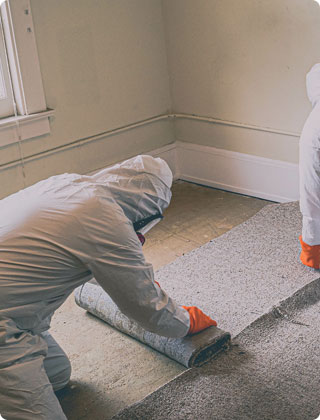MENU


Here at O2 Mold Testing, we really get how crucial Personal Protective Equipment (PPE) is. It's not just gear; it's a vital shield that keeps our team safe from the health risks that come with mold. Whenever we're out there testing or removing mold, we're fully geared up with top-notch PPE to keep everyone protected and healthy.
Breathing Easy: We pay attention to our breathing. To keep those dangerous spores out of their chests, our crew wears the best respirators in the game. Mold can be bad for your health if you breathe it in, so we're not taking any risks.
Ways to Think Long-Term: We all know that being around mold for a long time without the right gear is a bad idea. That's why PPE is always worn at O2 Mold Testing rather than just sometimes. Better health in the future is less likely to happen because of it.
Ready for Anything: Mold testing can take us to all kinds of places, and not all mold situations are the same. We make sure our PPE can handle whatever level of mold we're up against. Whether it's a little or a lot, we're prepared.
Giving our team PPE is one thing, but making sure they know how to use it? That's where our skills really shine. We teach people how to put on, take off, and take care of PPE on a daily basis. Not only will this keep us safe, but it will also help our gear work better. The point is to be smart and save money.
PPE at O2 Mold Testing is more than just following the rules. It's a promise to look out for our team's health and safety. It's not enough for us to find and get rid of mold; we also need to make sure that everyone stays safe. With proper PPE use and care, we make sure that our team is always ready and safe, no matter what kind of mold problem we're facing.
Because of these risks, it is very important to know how to effectively lower your mold exposure. If you live in a basement, bathroom, or other place with water damage, this is particularly important. Safety gear for individuals (PPE) is very important in this situation. Masks, gloves, and other protective clothing put up a wall between you and the mold spores. This makes it much less likely that you will touch or take them in. It is safe to look for, clean, and get rid of mold in your home or place of work as long as you wear the right PPE.
We always need PPE in every mold detection. We'll show you when it's time to suit up and protect yourself.
Diving into the world of mold testing tools, the right Personal Protective Equipment (PPE) is key. It's not enough to just throw on any protective gear; you need the specific stuff that's going to keep you safe from mold. We're talking about everything from your hands to your whole body.
Your hands are on the frontline, so protecting them is a must. Nitrile gloves are perfect for the job. They're like a mold-blocking shield, tough against rips, and super effective in keeping mold off your skin.
Getting anything in your eyes is a pain, but mold spores? That's not the same thing. Safety glasses are a must here. Make a screen that stops those mold spores in their tracks; they need to fit well around your eyes.
When mold is everywhere, you need to protect yourself even more. You need a suit that covers your whole body. It's like your own personal armor for fighting mold; it protects you from all sides as you face the mold head-on.
In mold testing, each piece of PPE has a vital role in keeping you protected. So, gear upright, and you'll be ready to face mold safely and effectively.
Protective clothing in mold testing is like choosing the right armor for battle. Here's the lowdown:
Breathing in mold spores is a big no-no. That's where your choice of respirator comes into play:
So there we have it. It's not just about wearing PPE; it's about wearing the right PPE. Think of it as gearing up for a mission - your mission being mold testing. With the right gloves, clothing, and respirator, you're more than ready to face those moldy menaces head-on, safely and effectively.
Alright, let's talk about gearing up in your PPE for mold testing. It's not just about being safe; it's about doing it right and feeling good while you're at it.
First thing first: wash those hands. It's like the golden rule. Then, it's time to step into your suit. Take it easy; no need to rush. Next up, gloves. Make sure they overlap with your suit so there's no skin showing. Goggles or a face shield come next - they should fit just right, with no pinching and no gaps. Last but not least, your mask or respirator. Adjust it so it feels snug, but you can still breathe comfortably.
Being in PPE for a while? Comfort is your best friend. Ensure your suit fits you just right - not squeezing you, not hanging loose. If it's too tight, you'll feel like a wrapped mummy; too loose, and you might as well be wearing a tent. If you can, choose PPE that lets your skin breathe a bit. And don't forget to take little breaks to stretch and get some air. Practicing wearing your PPE can help, too. It's like a dress rehearsal before the big show.
It's important to keep your PPE clean. Start with a fresh set. Take it off carefully when you're done. It's kind of like pulling an onion: you have to do it layer by layer and not touch the outside. Single-use things? Throw it in a smart way. Using old gear? Clean it the way the directions say to. After taking everything off, wash your hands and any skin that is showing.
That's it! A guide for people on how to wear PPE for mold tests. Making sure you're properly dressed, comfortable, and clean aren't just safety measures; they'll also help you do your best work when dealing with mold. Get ready, look out for germs, and have fun!
It's essential to dispose of your used Personal Protective Equipment (PPE) correctly, not just for the sake of rules but for our environment and safety, too. For single-use items like masks and gloves, don't just throw them in the trash. Seal them up in a bag first. And if you can find a way to recycle them, even better. It's all about leaving a smaller footprint.
PPE doesn't last forever. Just like you wouldn't drink expired milk, you shouldn't use old PPE. Regularly check your gear for signs of wear, like cracks or tears. And it's not just about looks - safety comes first. Remember, each piece of PPE, like respirator filters and gloves, has its own lifespan. Stick to the manufacturer's guidelines to know when it's time for a replacement.
When it comes to PPE, there are a whole lot of rules and standards. It's not enough to just have the right gear; you also need to know the rules, especially when checking for mold. Since these rules can change, it's part of the job to stay up to date. Staying safe and following the rules is everything.
The Occupational Safety and Health Administration (OSHA) is like the guidebook for PPE. They tell you what you need to wear, how to maintain it, and even how to get trained in using it. Their guidelines aren't just suggestions; they're essential for keeping you safe on the job.
Ignoring PPE protocols isn't something to take lightly. It's not just about breaking rules; it's about your health. Without the right PPE, you're exposed to nasty mold spores. And it's not just a personal risk. If you don't wear PPE, you could get in trouble with the law and be fined. Even worse, it could make your job dangerous for everyone.
To sum up, PPE is more than just gear; it's your safety net when you're checking for mold. Follow the rules at all times, use it well, and change it when it's worn out. Making sure you and your friends are safe is more important than just checking things off a list.
A guide to Personal Protective Equipment (PPE) for accuracy mold testing gives you a complete look at why PPE is so important in mold testing. This guide focuses on understanding, selecting, and using PPE correctly to make sure you're always safe in the field.